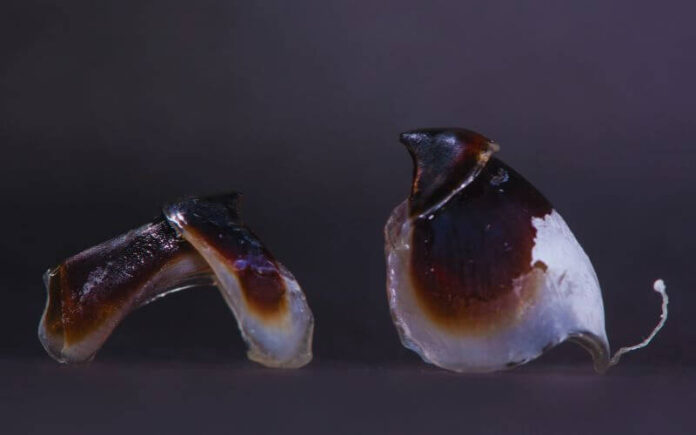The octopus is a creature that has long fascinated humans with its unique characteristics and abilities. From its intelligence and problem-solving skills to its ability to change color and texture, the octopus is a marvel of the animal kingdom. However, one of the most intriguing features of this cephalopod is its beak. In this article, we will delve into the anatomy, function, and significance of the octopus beak.
What is the Anatomy of an Octopus Beak?
The beak of an octopus is a truly remarkable structure. Located in the center of the animal’s arms, the beak is a retractable, parrot-like appendage that is used for feeding. The beak is made of chitin, a tough and durable material that is also found in the exoskeletons of insects and crustaceans. This hardness allows the octopus to easily tear through the flesh of its prey.
The beak itself is composed of two parts: the upper and lower mandibles. These mandibles fit together perfectly, like a pair of scissors, allowing the octopus to slice through even the toughest of prey. The beak is also equipped with a radula, a tongue-like structure covered in tiny teeth, which helps to further break down food before it is swallowed.
Do Octopus Have Beak?
Yes, all species of octopus have beaks. In fact, the presence of a beak is one of the defining characteristics of cephalopods, the group of animals that includes octopuses, squids, and cuttlefish. The beak is an essential tool for these animals, allowing them to capture and consume a wide variety of prey.
How Powerful is an Octopus Beak?
The beak of an octopus is incredibly powerful, capable of exerting a tremendous amount of force. In fact, the beak of the giant Pacific octopus, one of the largest species of octopus, has been measured to exert a force of over 1,000 pounds per square inch. This is more than enough to crush the shells of crabs and other crustaceans that make up a large part of the octopus’s diet.
But the power of the octopus beak goes beyond just its strength. The beak is also incredibly precise, allowing the octopus to carefully manipulate and tear apart its food. This precision is essential for an animal that lacks teeth and must rely on its beak to break down its prey into manageable pieces.
What Makes Octopus Beaks Stand Out in Photos?
One of the most striking features of the octopus beak is its appearance. In photos, the beak often stands out as a dark, curved structure amidst the soft, fleshy arms of the octopus. This contrast can make for some truly stunning images, showcasing the alien-like beauty of these creatures.
But the appearance of the octopus beak is more than just aesthetically pleasing. Its dark coloration is actually a result of its composition, with the chitin that makes up the beak being naturally dark in color. This coloration may also serve a functional purpose, helping to camouflage the beak and make it less visible to potential prey.
Exploring Different Types of Octopus Beaks
While all octopuses have beaks, there is a great deal of variation in the size, shape, and color of these structures. Some species, like the blue-ringed octopus, have relatively small beaks that are almost hidden by their arms. Others, like the giant Pacific octopus, have massive beaks that are impossible to miss.
There is also variation in the shape of octopus beaks, with some species having more pointed or curved beaks than others. These differences in shape may reflect differences in diet, with species that specialize in hard-shelled prey having more robust and powerful beaks than those that feed on softer-bodied animals.
Octopus Beak vs. Squid Beak: A Comparative Analysis
While both octopuses and squids are cephalopods and share many similarities, there are some key differences between their beaks. Squid beaks tend to be longer and more pointed than octopus beaks, reflecting their more streamlined bodies and fast-moving lifestyle.
Squid beaks are also typically lighter in color than octopus beaks, with some species having almost translucent beaks. This may be an adaptation to the deep-sea environments in which many squids live, where light is scarce and camouflage is essential.
Despite these differences, both octopus and squid beaks serve the same essential function – to capture and break down prey. And both are equally fascinating examples of the incredible adaptations that have evolved in these amazing animals.
Conclusion
The octopus beak is a truly remarkable structure, one that showcases the incredible adaptations and abilities of these fascinating creatures. From its powerful crushing force to its precise manipulations, the beak is an essential tool for the octopus, allowing it to thrive in a wide range of marine environments.
But the octopus beak is more than just a functional appendage. It is also a source of great beauty and wonder, with its striking appearance and alien-like form captivating the imaginations of people around the world.
As we continue to study and learn more about these incredible animals, the octopus beak will undoubtedly remain a subject of fascination and intrigue. And with each new discovery, we will gain a greater appreciation for the complexity and beauty of the natural world.
